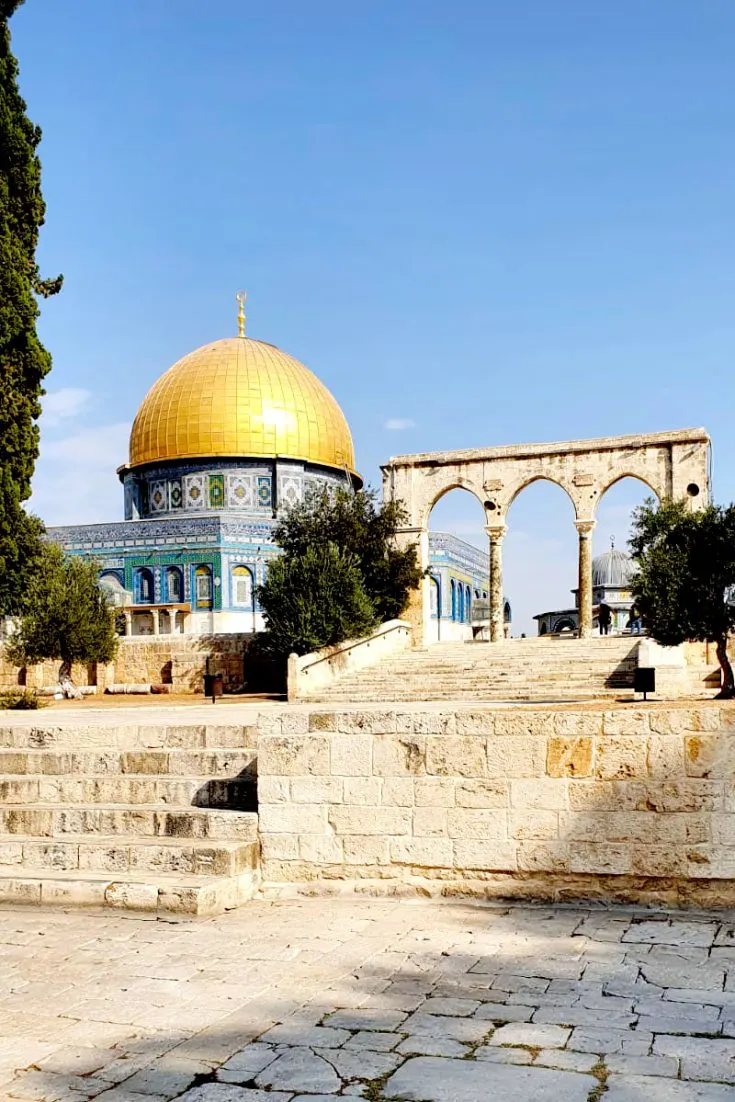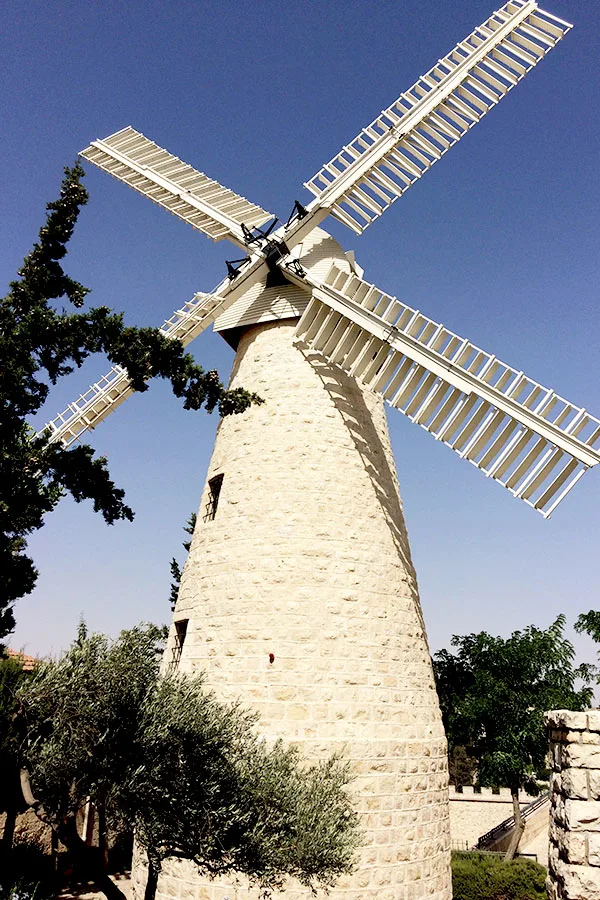This itinerary for spending 48 hours in Jerusalem on a budget allows you to get the most out of your trip without hurting your wallet.
There are so many great free things to do and see in Jerusalem that this doesn’t even cover it all!
For more ideas, see my post on all the things there is to do in Jerusalem on a Budget which also includes some great money saving tips.
Day 1
If you are staying outside the Old City then, if possible, start at Jaffa Gate. It is usually more continent and will let you experience more of the old city.
The Cardo was once the road and market place that ran through ancient Jerusalem. Today, you can walk through this archaeological site as the Romans and Byzantines.
As you follow the path you will reach an underground market filled with lovely shops built into vaults from the Crusader period.
This is one of my favorite parts of the Old City but if you're starting from Dung Gate or Zion Gate its not terrible if you leave it off.
The Temple Mount refers to the elevated plaza above the Western Wall that was the site of both the First and Second Jewish Temples. It is and always has been the holiest site in the world to Jews.
in the 7th century Muslims began viewing Jerusalem and the Temple Mount as a holy site. Today it is considered the third holiest sites to Muslims, after Mecca and Madina.
At the end of that century the shrine known as the Dome of the Rock was built on the Jewish holy site shortly and Al Aqsa mosque was as well shortly there after.
Non-Muslims are permitted to visit the plaza during set days hours. However they are not allowed to enter the Dome of the Rock.
The Western Wall or the Kotel, is the last remaining wall of the Second Temple. It is revered as a holy site because it is the closest to the Temple Mount Jews are legally allowed to pray.
In addition to Jews, many Christian tourists also come pray at at the wall.
Prayers there include regular Jewish prayers that are said three times a day, saying Psalms, and personal heartfelt prayers.
It is also tradition to leave a note asking G-d for things. These can be anything your heart desires, big or small.
The Kidron Valley is located between the Temple Mount and the Mount of Olives and has been equated to Petra.
In Hebrew the Kidron Valley, means the whole wadi, and the upper section that most people think of is referred to as Valley of Yehoshafat (Josaphat) or the King’s Valley.
The Valley of Yehoshafat was considered in ancient times to a part of the Mount of Olives, as part of the necropolis.
There are tombs here dating back to the First Temple and Second Temple periods.
From the tombs you can walk up the road to the Mount of Olives.
The Mount of Olives of has been used as a Jewish cemetery for over 3,000 years, dating back to biblical times, and was named for the olive groves that once covered its slopes.
The southern part of the mount was the necropolis, was the burial place of Jerusalem’s most important citizens, attributed to the ancient Kingdom of Judah.
It is largest and holiest cemetery in the Jewish world, containing some 70,000 graves.
It is the final resting place of well-known figures such as Eliezer Ben-Yehuda, Rabbi Abraham Isaac Kook, Rabbi Obadiah of Bertinoro (Bartenura), Rabbi Yehuda Hehasid (Rabbi Judah the Pious) and Holy Land scholars Rabbi Yehosef Schwartz and Samuel Klein.
From here you can take a bus back to the old city or walk back the way you came.
The Chamber of the Holocaust was the the world’s first Holocaust memorial and is a powerful yet little known museum by Israelis and tourists alike.
It was built as a symbolic cemetery, as a place for Holocaust survivors to cry and mourn for their families, especially if they didn’t know where their loved ones were buried.
The memorial was established in 1949, four years after the end of World War II and a year after Israel was founded, as Holocaust survivors who came as refugees to the country sought a place to grieve.
Built in a Crusader dungeon, the chamber was a place for Holocaust survivors and victims’ descendants to light memorial candles, recite the Kaddish, remember, and mourn.
Today, it is a museum and the objects, on display were donated by Holocaust survivors and victims’ families as a memorial to those who perished.
Admission is free, but donations are appreciated since the museum funded largely by private donations.
Lunch
You can get street food on the way to Mahane Yehudah like shawarma, falafe, or sabich.
Or you can see what's in the market and get from there. You have all kinds of restaurants, street food places, and fresh fruit stands (and the fruit is amazing).
Mahane Yehuda Market more often referred to as “The Shuk” is a favorite of locals and tourists alike.
The main street is lined with stands selling fruits, vegetables, and nuts with clothing and gift shops sprinkled in between.
However, if you go down the opens in the main path you'll find a whole other world with restaurants, cafe's, bakeries, jewelry shops, and so much more.
While there are many ways to spend money in Mahane Yehuda, exploring it is completely free.
Montefiore’s Windmill was one of the first Jerusalem landmarks to be built outside the Old City walls.
It was built in 1857 by Sir Moses Montefiore where he would later build Mishkenot Sha’ananim which became first neighborhood in Jerusalem outside Old City.
Today, the windmill houses the Jerusalem Vineyard Wineries Visitor Center.
Near by in a glassed-in room is a replica Montefiore’s carriage which he used in his travels.
Ketef Hinnom is a little known archaeological site consisting of a series of rock-hewn burial chambers dating from the First Temple period.
This archaeological site is located behind the Begin Heritage Center Museum.
You can reach it by through an opening in the gate coming from the main road walking towards the museum.
Today, First Station – known in Hebrew as HaTachana HaRishona – was once a busy railway station filled with hustle and bustle.
Today it’s a chic lively place filled with restaurants, shops, and events locals love.
Tour the First Station and walk down the tracks like locals do. Notice the art and bus stops that have been reperused into libraries.
This is a great place for dinner but not the cheapest.
Dinner
Walk back to Mahane Yehudah and enjoy the restaurants that line Agrippas street.
Or explore the center of town and find something delicious on Shlom Tzion HaMalka street.
Day Two
Day 2 is spent seeing one of Israel's most famous museums and popular tourist attractions as well as two sites important to Israelis.
Yad Vashem is the Holocaust History Museum and Israel’s memorial to the victims of the Holocaust.
Established in Jerusalem in 1953, Yad Vashem has become the most visited site after the Western Wall.
It is dedicated to preserving the memory of the dead, honoring Jews who fought against their Nazi oppressors, and Gentiles who selflessly aided Jews in need.
The focus of this museum is remembrance, education, documentation, and research related to the Holocaust.
Together with the Chamber of the Holocaust, it tells a very important part of Jewish History.
Time to Eat
Yad Vashem has both a kosher meat cafeteria and kosher a dairy cafeteria. This is a residential area, so unless you feel like walking 10 or 20+ minutes out of the way for one of the half a dozen eateries in the area, this would be a great time to stop and have a bight before moving on with your day.
Mount Herzl is the site of Israel’s national cemetery where Israel’s fallen soldiers are put to rest.
Many of the Jewish state’s leaders are also buried here including Herzl himself.
This site of major national importance. It is where the families of the fallen file in crowds through the gates of Mount Herzl to attend the state Remembrance Day ceremony.
The Herzl Museum is the only site on the list that isn't free, but it's entrance fee is pretty cheap.
The museum gives you insight into the life and activities of Theodor Herzl, the founder of the modern Zionist movement.
It details his life and many contributions to the Zionist cause.
It also provides a glimpse into Herzl’s analysis of the Jewish condition, a portrayal of his ambitions, vision, disappointments and achievements, and the challenge of his legacy.
The museum is split into four exhibition spaces, three of them showing different eras of Herzl’s life.
From the beginning of his life in Vienna and the Dreyfus trial, through the Zionist Congresses in Basel, until his early death at the age of 44.
The highlight of the tour is the fourth room where visitors are given a view of the accomplishments of the Jewish state, despite the many difficulties and hardships.
The Jerusalem Forest is a favorite by locals and has many playgrounds and picnic areas in it along, with a hiking trail.
It is filled with pine and cypress trees, as well as Palestine oak, terebinth, carob, olive, fig, pomegranate, and other species that used to cover the slopes of the Judean Hills.
On many of the slopes there are agricultural terraces, burial caves, wine-presses, and cisterns from ancient times.
Gazelles often run in the area and and you can hear the sounds of the the many songbirds who live in the trees.

